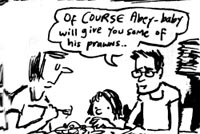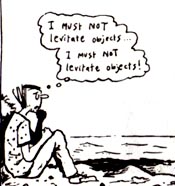>> The Friday Review: Pubo
>> The Friday Review: Get Your War On
More...

 Writer/Artist: Glenn Dakin
Writer/Artist: Glenn Dakin
Price: $14.95
Publisher: Top Shelf Productions
ISBN: 1-8918-3022-8
We've all been there, I'm sure. A moment in time where you suddenly stop and ask of yourself all the important questions in life. Who am I? Where am I going? What's it all about? A sudden bout of introspection - a moment of alienation that allows you to view yourself and your life objectively, and realise great truths about both.
Sometimes these moments will be triggered by a specific event; other times they'll just creep up on you when things are quiet and you're alone. While every such moment doesn't always yield an epiphany, you soon learn that when you find yourself asking these questions, it's important to stop and listen to your answers.
I bring this up because insofar as Glenn Dakin's ABE is about anything, it's about moments like these.
Glenn Dakin was one of several exciting and innovative British cartoonists to emerge from the small press movement of the early eighties. Together these artists prompted the thriving UK 'comix' scene of the latter half of the decade. Along with contemporaries such as Phil Elliot, Shaky Kane and of course, Eddie Campbell, Dakin broke new ground in the medium; not just in specialist anthology titles like ESCAPE and PSSST, but also in music magazines like SOUNDS and the NME - achieving a level of mainstream credibility that hadn't been seen before, or indeed since.
It's a strange and really quite sad twist of fate, then, that Dakin is now probably best known in the UK for his ROBBIE THE REINDEER: HOOVES OF FIRE adaptation - his groundbreaking work on strips such as PARIS and THE MAN FROM CANCER being largely unknown to the present generation of comic book readers. Hopefully this new collection, salvaging nearly fifty of Dakin's classic ABE/CAPTAIN OBLIVION strips from their various disparate homes both far and wide, will go some way towards balancing things out.
 Abe is Abraham Rat; a bespectacled and big nosed proto-slacker who, at least in early strips, lives on a far-flung future Earth and leads a double life as the disillusioned and semi-retired superhero, Captain Oblivion.
Abe is Abraham Rat; a bespectacled and big nosed proto-slacker who, at least in early strips, lives on a far-flung future Earth and leads a double life as the disillusioned and semi-retired superhero, Captain Oblivion.
Alienated from society and at times unhealthily introspective, Abe muddles his way through a series of mildly satirical 'adventures', philosophising about life as he goes about thwarting the diabolical schemes of the evil Milton Keenz, and caring for annoying, telepathic Martian refugees. Whilst these early stories are light, fluffy and occasionally funny, they don't really stand out as anything particularly special. Over the first fifty pages or so, however, there's a gradual shift of tone and emphasis, and ABE slowly becomes something much more interesting.
As Dakin himself matures, so too does his subject matter. ABE becomes a vehicle not just for satire, but for just about whatever Dakin is interested in at the time, including thinly veiled autobiography, poetry and travelogues. Meanwhile the character of Abe himself evolves into Dakin's cartoon alter ego - a cipher for his thoughts and obsessions. The playful future world and superheroics of the early strips are discreetly jettisoned, returning only on rare occasions.
Given the heavy autobiographical content, the obvious (and lazy) comparison to make is with Dakin's contemporary and friend, Eddie Campbell, and particularly with Campbell's ALEC stories. (Campbell writes the introduction to the book, and he and his daughter Hayley put in an amusing cameo appearance inside; Dakin meanwhile, was a prominent character in Campbell's HOW TO BE AN ARTIST.)
ABE, however, is considerably more abstract and thoughtful than ALEC, which even at it's airiest, remains grounded in the physical realities of life. Dakin will certainly use autobiographical anecdotes to make his point, but the focus is always on the expression of feelings and ideas - the inner life of the imagination.
 Dakin also has a far more keenly developed sense of whimsy than Campbell, and he is by no means averse to suddenly dropping fantastical elements into an otherwise mundane story (see 'Abe and the Fairies'). This, along with the generally meditative, introspective tone of the book, gives ABE a very 'borderline' feel, as if it takes somewhere between dreams and reality.
Dakin also has a far more keenly developed sense of whimsy than Campbell, and he is by no means averse to suddenly dropping fantastical elements into an otherwise mundane story (see 'Abe and the Fairies'). This, along with the generally meditative, introspective tone of the book, gives ABE a very 'borderline' feel, as if it takes somewhere between dreams and reality.
This is made explicit in the book's last piece, 'A Dream England', in which Abe, accompanied by a troll, explores a winter golf course and, upon meeting King Arthur, declares himself one of the "re-enchanted"; part of an old, magical world that's slowly coming back. It's a theme that underlies many of the stories in the collection, and restoring a sense of wonder to the world in which he lives in is clearly one of Dakin's chief obsessions.
Dakin's deceptively simple drawings give ABE an artist's sketchbook feel; there's a real sense of spontaneity and invention, as if Dakin were sketching out his thoughts directly onto the page as they occur to him. Given that much of the book consists of Abe's stream of consciousness rambles, this feels particularly appropriate.
Just because the art is very loose and scribbly, however, doesn't mean it's rushed or poorly executed in any way. As Campbell notes in his introduction, Dakin's carefully chosen drawings service his words perfectly, functioning almost as calligraphy. ABE is comics as "visual poetry".
Perhaps predictably, the collection ends abruptly, in a quiet, understated fashion. Dakin signs off by saying he can't show us any more - he's only come this far himself. With just one panel, Dakin manages to bring a perfect sense of closure to nearly twenty years' worth of work. It's appropriate of course, because no matter how rewarding thinking about life is, sometimes you've just got to get on with living it.
A wonderfully reflective and highly skilled marriage of words and pictures, ABE is one of those books you just know you're going to come back to.

This article is Ideological Freeware. The author grants permission for its reproduction and redistribution by private individuals on condition that the author and source of the article are clearly shown, no charge is made, and the whole article is reproduced intact, including this notice.


